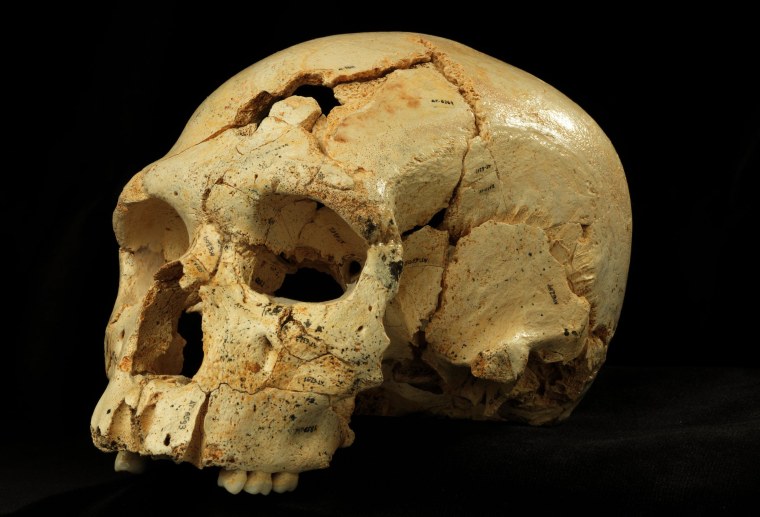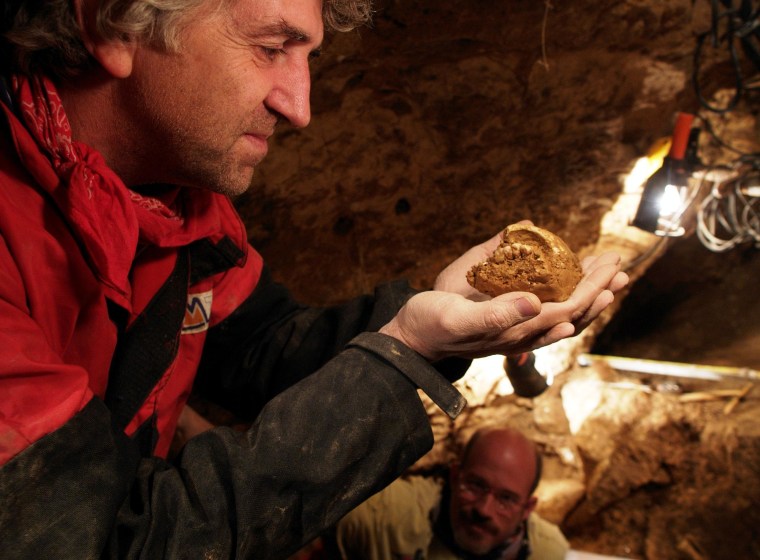Skulls found in a Spanish cave suggest that the physical features of Neanderthals and humans diverged in stages, starting with the face and teeth, researchers reported Thursday.
"It is now clear that the full suite of Neanderthal characteristics didn't evolve at the same pace," said Juan-Luis Arsuaga, a paleontologist at the Complutense University of Madrid and the lead author of a study published in this week's issue of the journal Science.
Sign up for Science news delivered to your inbox
In the report, Arsuaga and his colleagues lay out their scenario for human evolution, based on an analysis of 17 reconstructed skulls found deep within the Sima de los Huesos cave in Spain. Arsuaga said the findings were consistent with a "Game of Thrones" evolutionary saga, with communities (or "houses") of humans and their distantly related kin competing for habitat more than 400,000 years ago.
Winter was coming
During that era, glaciers were creeping southward from northern Eurasia, adding to the evolutionary pressure on different groups of hominins — a category that includes modern-day Homo sapiens, now-extinct Neanderthals and other humanlike species. "Winter is coming," Arsuaga said, echoing the motto associated with one of the houses on "Game of Thrones."
The pressure to survive probably caused communities with advantageous traits to gain more of a foothold amid violent conflicts with other groups. "It was not a matter of a gradual and slow, generation-after-generation accumulation of small changes by the entire European population," Arsuaga told NBC News during a teleconference on Thursday.
Some Neanderthal-like traits are reflected in the skulls from the Spanish cave. For example, they had protruding front teeth, and the joint for the jaw was relatively low. To modern eyes, their chin would have looked weak or even non-existent.
"It seems these modifications had to do with an intensive use of the frontal teeth," Arsuaga said in a news release. "The incisors show a great wear, as if they had been used as a 'third hand,' typical of Neanderthals."
The Sima de los Huesos hominins may have used their front teeth "to grasp things, possibly meat ... and they were cutting into pieces," Arsuaga told reporters Thursday.
Nearly Neanderthals
The cave people also had the thick browline associated with Neanderthals. However, their braincases were smaller than those of Neanderthals as well as modern-day humans. That suggests that they were part of the Neanderthal lineage, but not yet true Neanderthals, Arsuaga said.
He held off from classifying the skulls as a new species within the genus Homo, and said it was too early to say whether humanity's family tree needed to be reworked. However, he said those issues would come up for further discussion in the next month.

Years ago, Arsuaga and his colleagues put the age of the Sima del los Huesos fossils at about 600,000 years — and classified them as Homo heidelbergensis, an ancestor to Neanderthals as well as us Homo sapiens types.
Since then, better methods for dating fossils from that age have led them to revise their estimate. The current estimate is that the bones are at least 430,000 years old — which is consistent with the view that they're on the branch of the family tree leading to Neanderthals, but not there yet.
The revised estimate met with approval from Chris Stringer, a paleoanthropologist at London's Natural History Museum who was not part of Arsuaga's team.
"The rich Sima de los Huesos material, with every part of the skeleton beautifully preserved, will continue to inform us human evolution 400,000 years ago as research continues on this astonishing, and even beautiful, collection of human fossils," Stringer said in an email.
Arsuaga is one of 30 co-authors of the Science paper, "Neandertal Roots: Cranial and Chronological Evidence From Sima de los Huesos."
